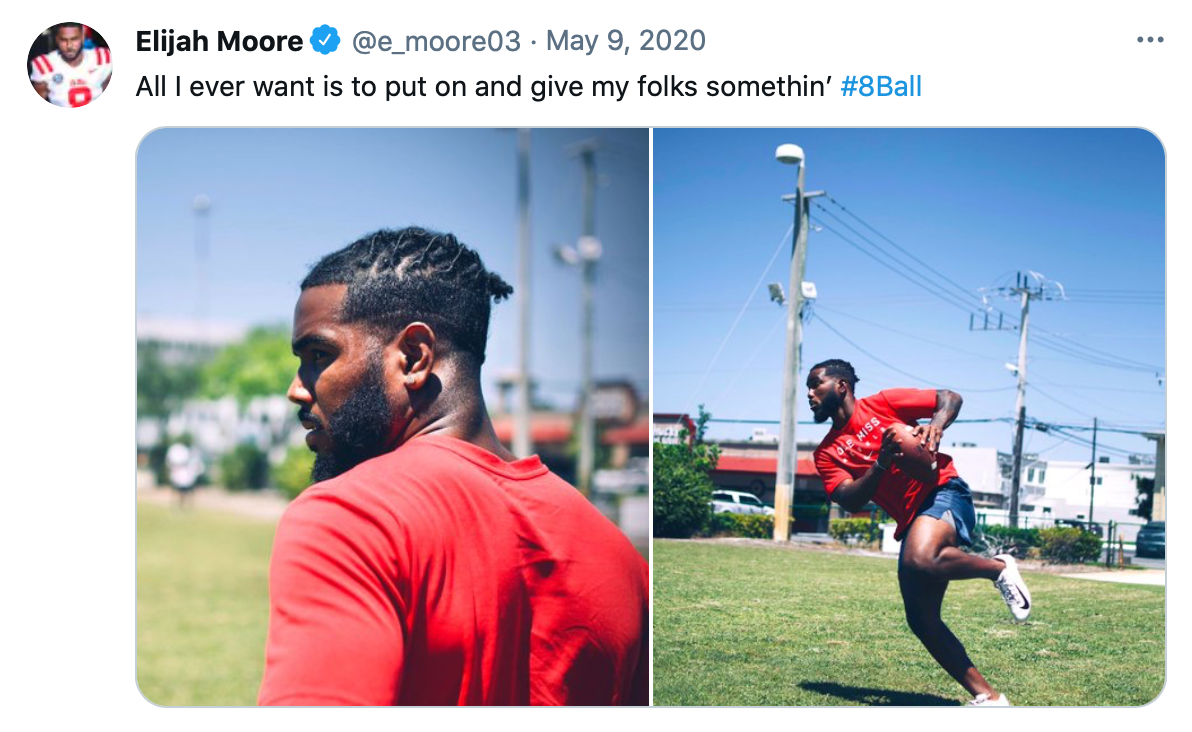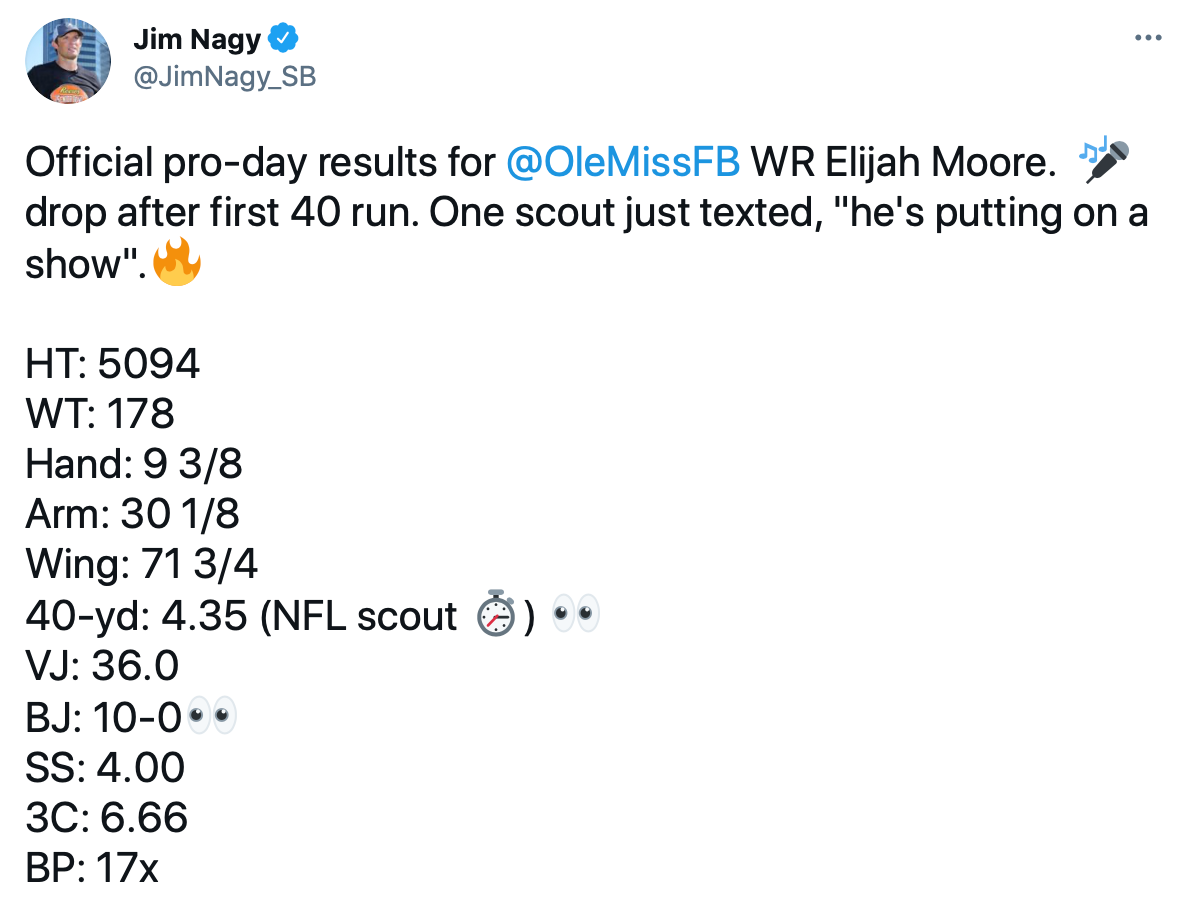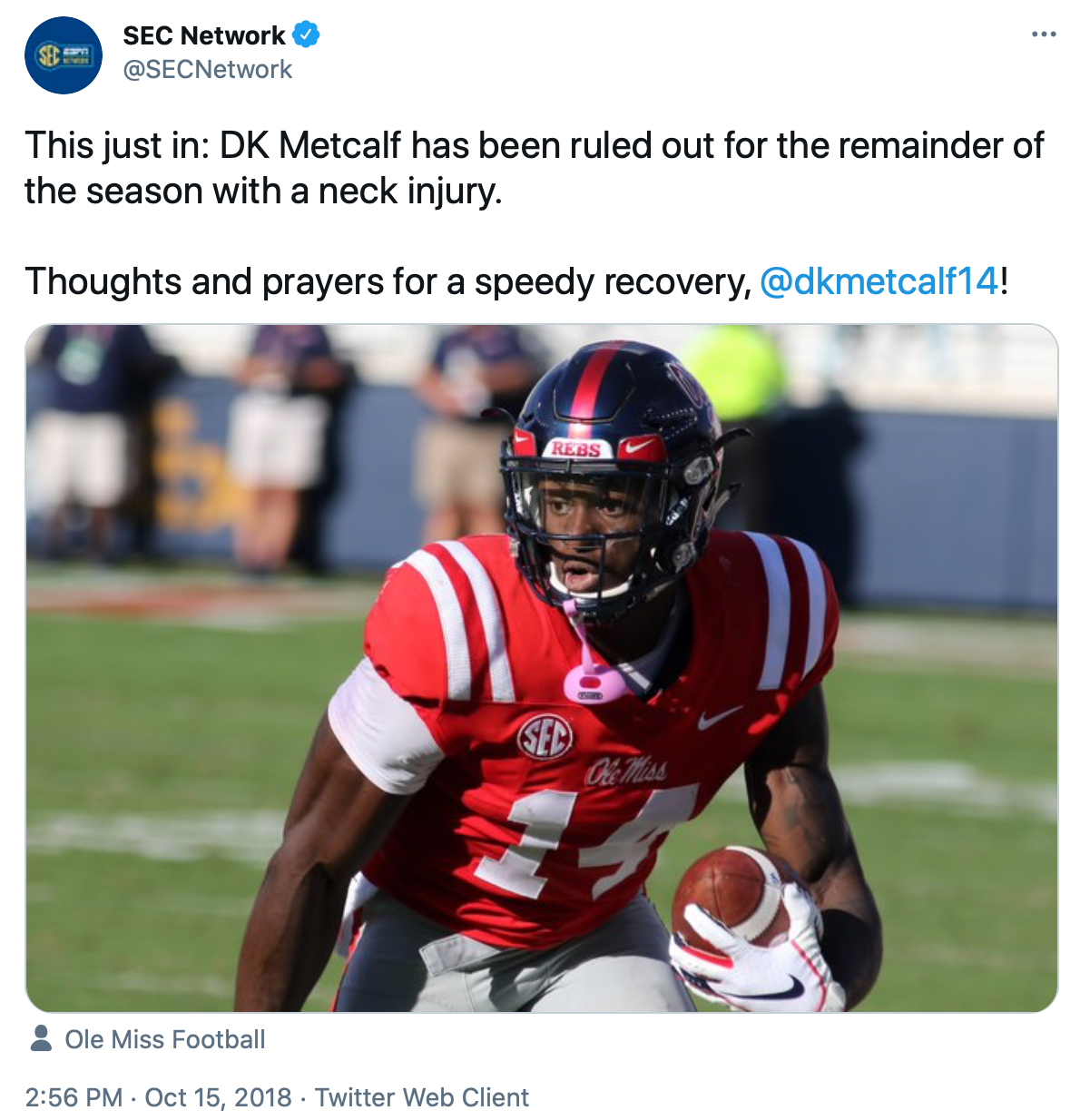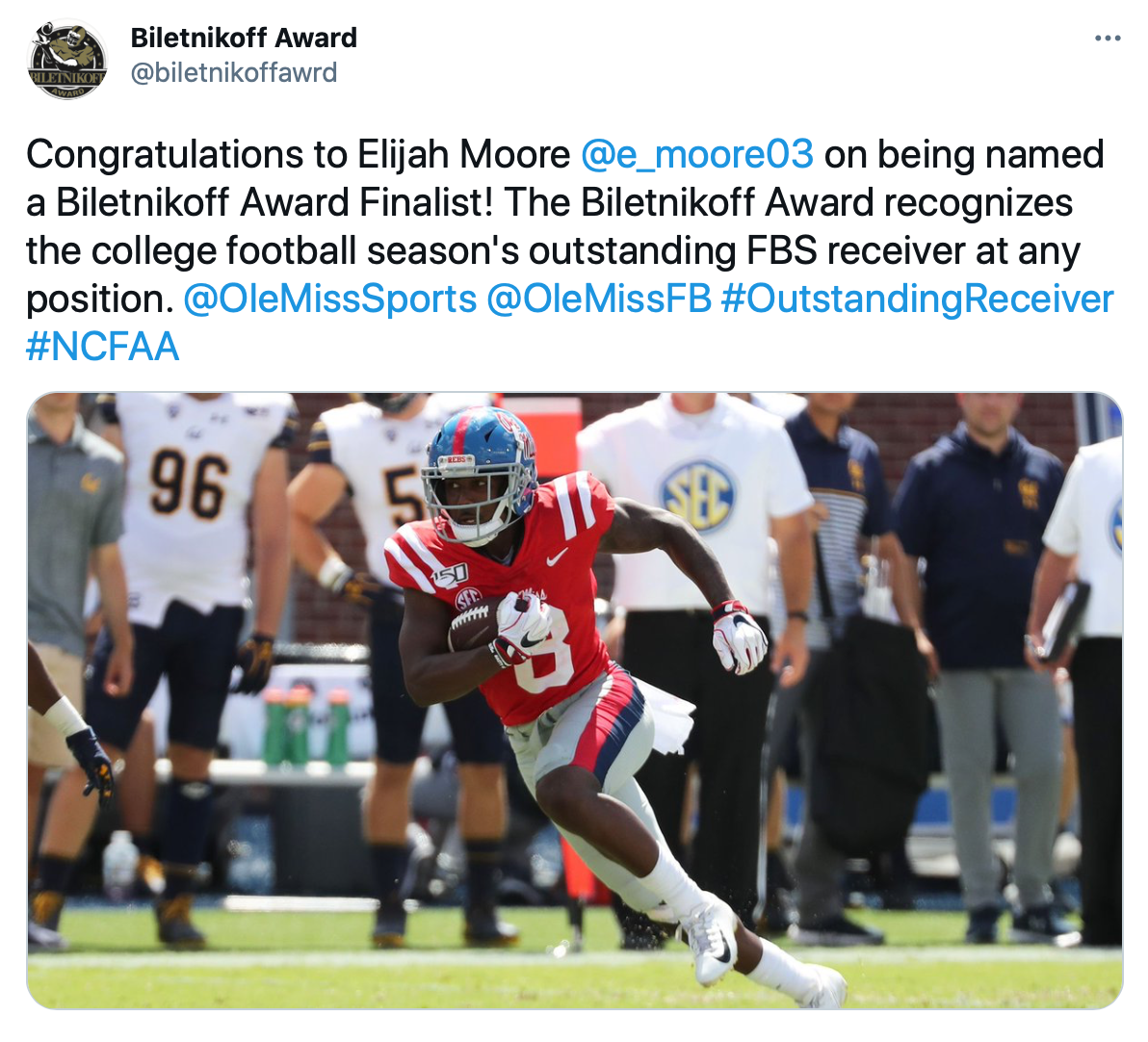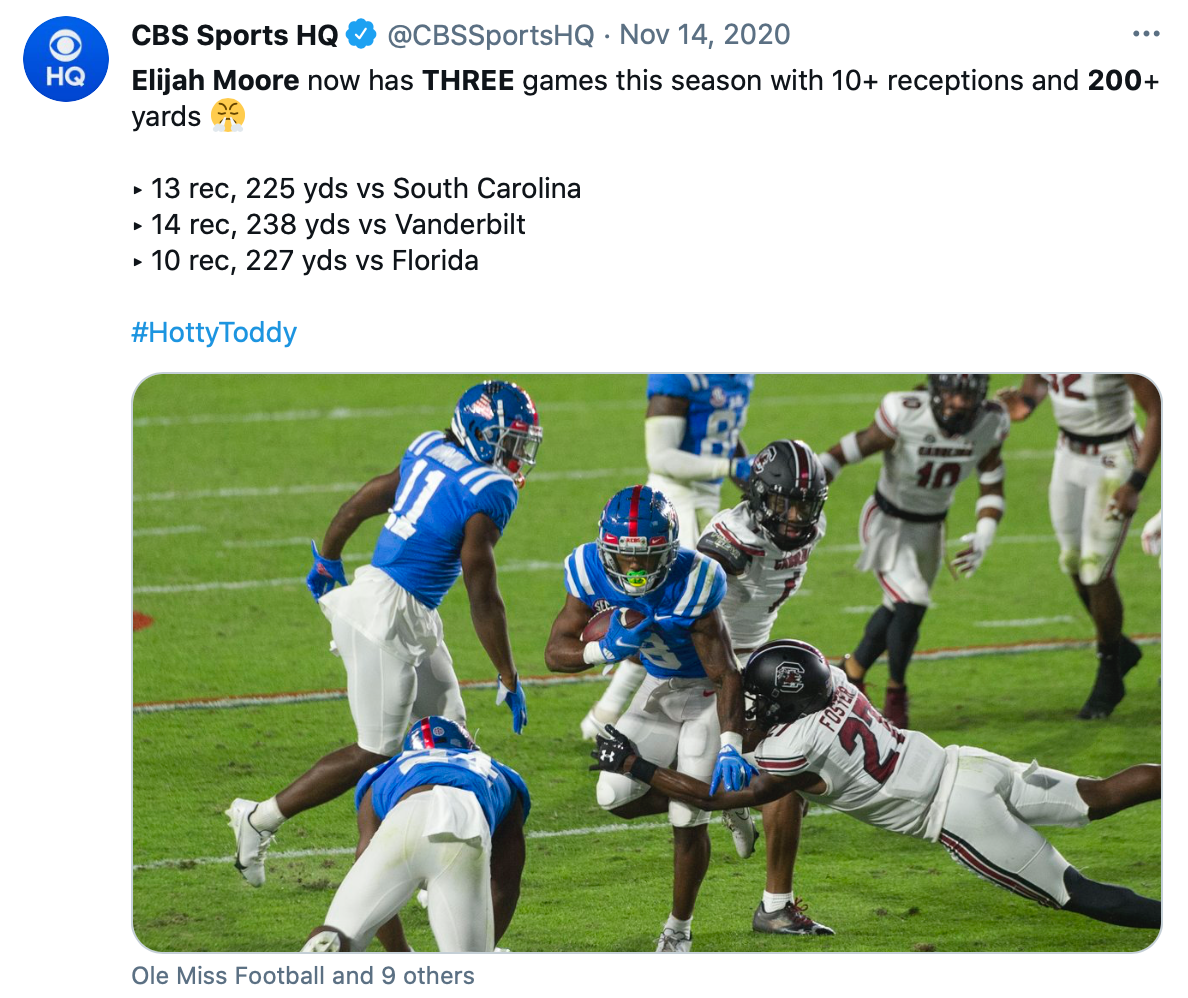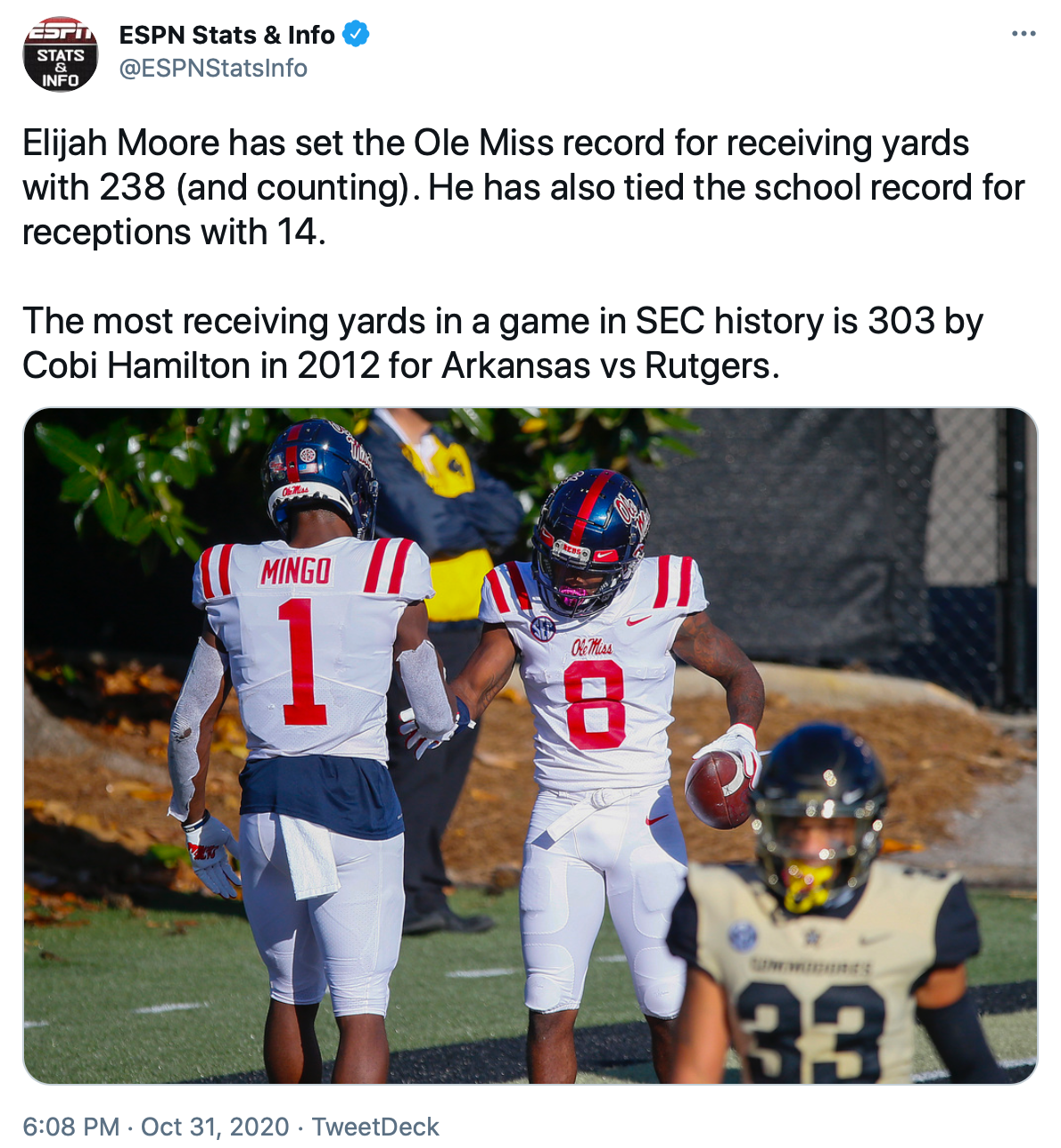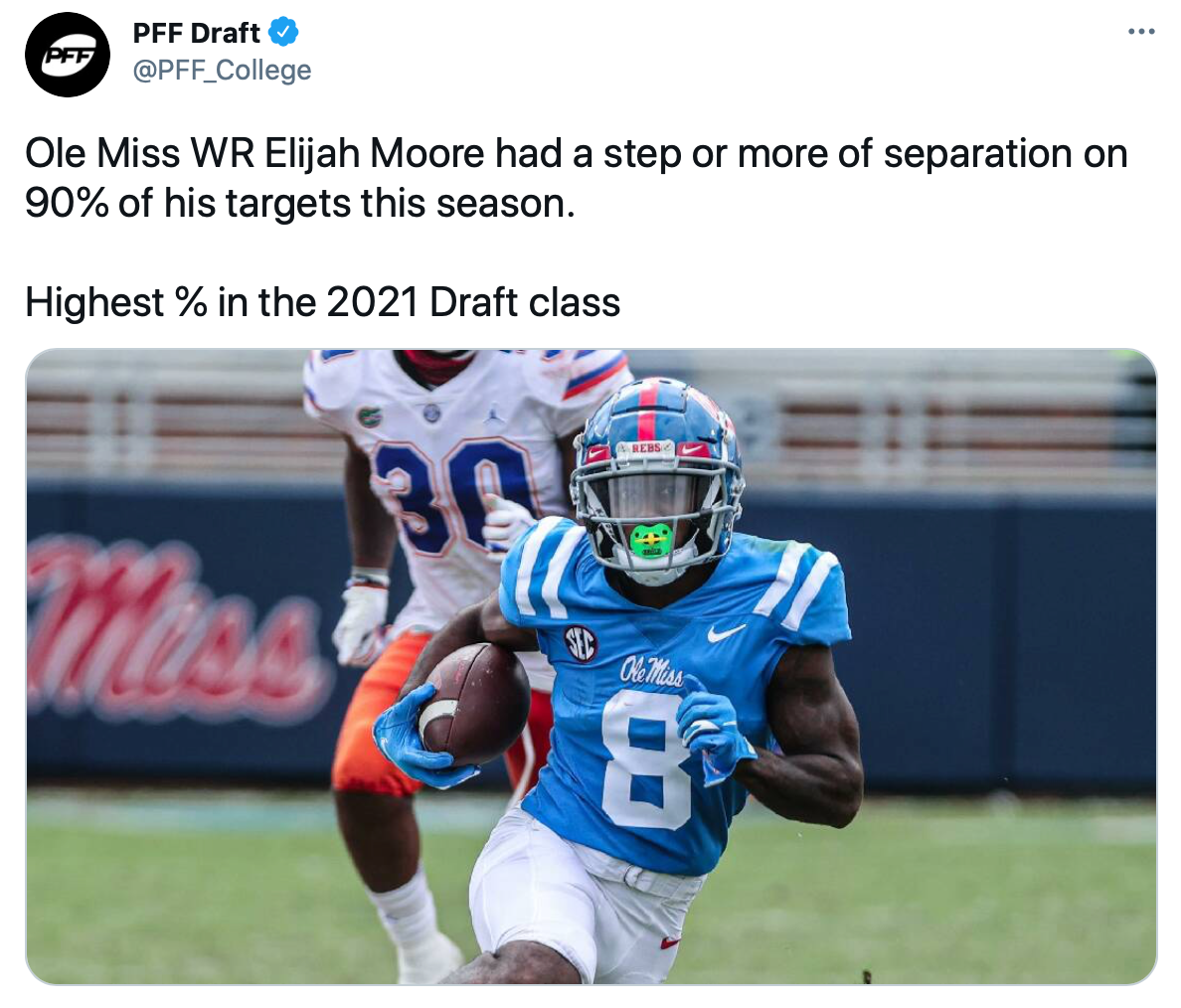Elijah Moore
WR | Ole Miss Rebels | 5-9 3/8 | 189 lbs.
Rookie Expectations
Over the last three NFL seasons, wide receivers who predominantly lined up on the outside have run five particular routes for about 75% of total routes. Those five routes are Gos, Hitches, Outs, Slants, and Crossers. For WRs playing from the slot, these five routes are also featured, at slightly altered percentages, for a nearly identical combined total. The final 25% will be distributed among Ins, Posts, Corners, some Screens, and the rest on exotic combo routes when split wide. For slot WRs, the majority of that 25% will go toward Screens and shallow work in the flat. Whenever I make references to “NFL routes” in these Dyno rookie profiles, those are the guidelines I am following.
The Story
The public persona of Elijah Moore is much different from his personality in the locker room. He took on a leadership role with Ole Miss dating to his true sophomore season. However, after literally watching every available interview and press conference from, Moore is just not one to ever give away more information than necessary. Most of the answers Moore passed along to reporters were laden in football aphorisms. (Maybe he’s already auditioning for a coaching career?)
Moore has only a three-line description for his entire high school career on his Ole Miss profile. Roughly 95% of his profile has been filled out with the data from his career with the Rebels, information that was easily accessible. The only additional details from his personal life discovered elsewhere include being born in Davie, Florida, and his older brother, Sean Moore Jr., previously playing cornerback collegiately for Murray State University. The message below is easily the most revealing personal detail discovered.
Moore attended Davie Western High as a freshman and sophomore. No matter how much time is devoted, you will not be able to uncover the production from his sophomore year for HC Jermaine Hollis. But I’ve collected those numbers using his Hudl footage of his 10th grade season. Moore turned 49 receptions into 1,210 yards and 17 TDs. He added a pair of return TDs toward earning an honorable All-State mention. Moore transferred 18 miles away to play his final two seasons for a St. Thomas Aquinas team that had collected six FHSAA 7A Florida State Championships during the previous nine seasons. However, Moore found himself playing behind a list of talented WRs, including Trevon Grimes, Josh Palmer, Mike Harley, Tavares Kelly Jr., and Jonathan Moore. His first season in blue and gold returned nine receptions, 42 yards, and a single TD. Although, the Raiders took home yet another state title over Tampa Plant 45-6.
Joining St. Thomas Aquinas placed Moore under the tutelage of WR coach and NFL Hall of Famer Cris Carter — likely the major draw. In his final HS season, Moore caught 28 balls for 407 yards and five TDs. The Raiders ended the season with a 27-20 loss to Venice HS in the state semifinals, dropping the school’s national ranking from 7th the previous season to 151st. Despite the limited output, Carter and HC Roger Harriott did a tremendous job guiding Moore toward the attention he deserved. It's fitting with Moore’s preference for privacy that we do not have a reported 40-yard, or Short Shuttle time from his attendance at The Opening Regionals in Orlando. The only reported measurement is a 30.9-inch Vertical Jump that would place in the 20th percentile among NFL Combine WRs over the last seven seasons. Moore took home the WR MVP Award for his performance. But, as you can check out the reasoning here, scouts took immediate notice of his massive potential.
The “C” point on Moore in the Tweet above would bring down some unwanted attention on his shoulders further down the line. He entered with the Class of 2018 as a unanimous four-star, ESPN’s WR25, 247Sports’ WR54, and as Rivals’ WR33. An impressive 26 Power Five scholarship offers were extended to Moore, including Alabama, Ohio State, Georgia, LSU, Miami (FL), Auburn, Oregon, and Michigan. After making an early commitment to Georgia, the unrelenting recruiting efforts by Ole Miss WR coach Jacob Peeler (current Texas State OC) flipped Moore’s journey to Oxford, Mississippi. But the Rebels nearly lost out on Moore when he learned that former HC Hugh Freeze was forced to resign due to recruiting violations. Moore was actually on a flight, en route for an unofficial visit when he received the news.
Ole Miss was handed a two-year postseason bowl ban and scholarship reductions stemming from the violations. After some contemplation, Moore stuck with Ole Miss due to his belief that the Rebels would focus on a pass-heavy offense under incoming, now former HC Matt Luke. Moore saw his most extensive early-season action as a true freshman facing Group of Five opponents Kent State (4/30/0) and Louisiana-Monroe (4/59/1). When DK Metcalf suffered a season-ending neck injury in Week 7, and Braylon Sanders injured his ankle the following week, Moore received his first career start facing South Carolina. He proceeded to set the school’s freshman record for the most receptions (11) and yards (129). He nearly matched his season’s totals from the previous eight games (12/166/2) in a single outing.
Some of the opinions passed about when OC Phil Longo vacated to take the same role with the University of North Carolina did not age well. I am entirely convinced Moore was not amused. He led the Rebels with a 67/850/6 receiving line but Longo’s replacement, Rich Rodriguez, installed John Rhys Plumlee as his starting QB. Plumlee threw down 1,023 rushing yards, 12 TDs on SEC defenses, thanks to the offense shifting to a run-heavy approach, which was not quite a fulfillment on the sales pitch made to Moore during his recruiting. Whether or not it played a role, the bitter Egg Bowl-rivalry against Mississippi State brought out some very uncharacteristic behavior from Moore.
After catching a two-yard TD pass in the closing seconds, Ole Miss would only need an extra point conversion to push the game to overtime. However, Moore’s post-score celebration involved mimicking a dog urinating — memorialized as the “Piss Six.” The spot of the extra point attempt would be moved back 15 yards, and the Rebels ended up losing 21-20 after the attempt was missed. As you might expect, Moore drew a ton of criticism for the unsportsmanlike behavior. Moore ended up making the following statement: “It was an emotional moment, and I deeply regret it. It does not represent who I am or who we are as a team, and I will grow stronger from this mistake." During the previous season’s Egg Bowl, Metcalf carried out the very same post-TD celebration. And they were both inspired by Odell Beckham Jr.’s end zone celebration from two months prior.
Dedicated to drawing attention to the legal components of his on-field performance, Moore successfully assembled a memorable conclusion to his Ole Miss career. That said, he would need to make the necessary adjustments under an entirely new coaching staff. Lane Kiffin took over the team, Jeff Lebby was brought over from UCF to coordinate the offense, and Joe Jon Finley became the Passing Game Coordinator — a new role on staff for the Rebels. The one holdover was Derrick Nix, oddly shifting from a 12-year stint as the RB coach to coaching the WRs. But you can’t argue with the results. Moore set the school record with 86 receptions in only eight games. He fell 127 yards shy of A.J. Brown’s yardage record of 1,320 set in 12 games during 2018. And he took a ball 91-yards to the house facing South Carolina to collect the school record for the longest receiving TD.
The Attributes
Just checking the numbers suggests Moore can play. But playing within a Kiffin offense already packs along expectations for fireworks. Kiffin is one of the best at putting his players into space. It’s true that Ole Miss accumulated the seventh-most yardage. But the Rebels fielded the 11th-worst scoring defense (38.3 PPG), allowed the third-most passing YPG (312.1), permitted the 17th-highest rushing yards/attempt, and fifth-most rushing TDs last season. Easily one of the worst units in the nation, Ole Miss ranked 126-of-127 schools in total defense — authorizing 519.0 total YPG. Kiffin wound up collecting four-of-five total victories in Oxford over the second-half of the season facing teams with considerable QB concerns. Setting aside the film, anything less than a phenomenal athletic showing would curtail Moore’s draft stock.
Let’s just say jaws hit the floor — including my own — when Moore worked through his testing at the Ole Miss Pro Day. He recorded a 4.35-second 40-yard dash (18.81 MPH) that places him in the 80th percentile among WR Combine participants over the last eight years. He added a 4.00-second Pro Shuttle (78th), 36-inch Vertical Jump (48th percentile), 121-inch Broad Jump (39th), and even added 17 reps on the 225-pound Bench Press (52nd). But the 6.67-second 3-Cone (86th) could be his shining moment. Moore’s get-off from the line of scrimmage is extraordinary. That explosive release combined with outstanding footwork define his presence. And the tape only furthers the intrigue.
True Freshman Season (2018)
W10 vs. South Carolina | W11 at Texas A&M | W12 at Vanderbilt | Highlight Reel
(Quick note: the easiest way to view these games from YouTube — while also avoiding the ads — is to download the files using a YouTube Downloader. My recommended media players are QuickTime (Mac) or VLC).
We’ll attack each of his seasons using an available highlight reel, as well as one-to-two full games. I’ll also provide additional links to other freely available full games for you to explore on your own. For Moore’s first season on campus, we’ll begin with his first career start after Metcalf’s season-ending injury facing South Carolina. The Rebels would employ a different OC during all three of Moore’s seasons. The 14 plays from this Week 10 matchup facing the Gamecocks will include more Run-Pass Options (RPOs — 9) than each of his other three full games we’ll view combined (7). Moore ran every single route charted from H (Slot) — making for easy identification.
The first series of plays will show Moore — No. 8 Jersey — on Designed Screens (6:19, 22:38, and 2:02:09), all three on RPOs. The first exploits Moore’s quickness on a Bubble against Cover 6. The next gains minimal yardage, but also the first down. The third example highlights his burst in picking up valuable red zone yardage that resulted in a Scottie Phillips TD run on the next play. Nearly one-fifth of all routes NFL Slot WRs are asked to run will target the Flats.
The next quartet of plays display Moore going up against the Cover 3 scheme. Elijah gained 32% of his ‘18 receiving yardage on under 25% of his routes defended by Cover 3. It’s a zone defense focused on stopping the run, while protecting against the deep ball. But it leaves two of the six underneath zones uncovered. You can see Moore attack one of those on an Out at 9:14 in the video. But we see at the 18:38 and 51:56 marks in the footage that Moore is already dangerous attacking those three deep zones, as well. And he makes an outstanding one-handed grab on a Slant at 52:40. Let’s close out Moore vs. zone coverage with the Slant defended by Cover 4 at 38:25. The shake he applies to snap R.J. Roderick off at the ankles is a prelude to the future.
The capacity to break away from Man coverage is vital to a receivers success in the NFL. Man concepts may not be considered as risky, on a single-play disaster basis, as Cover 4 but, as a whole, are far more vulnerable to the pass. Offenses that utilize H receivers in a base “Posse” (11) personnel will frequently force the opposing strong safety into man-to-man coverage. SC avoids falling into that trap. Instead, we have the viewing pleasure of Moore in a future NFL star, true freshman clash across from the Man coverage of Jaycee Horn on our next quartet of examples. On the first (38:50), Moore shows off that lightning-footwork on a Slant. Horn is all over Moore on a Cover 0 island at 56:08. Horn moves into position to try to jam Moore at 1:24:25, easier said than done. Moore eludes Horn, then calls on his footwork on a Comeback to convert on third-and-nine. Our final example is found at 1:58:15. Had Jordan Ta’amu not short-armed his throw down the seam, Moore is turning this into six points.
Let’s break out the highlight reel to complete our review of Moore’s true freshman season. Apologies in advance if the music offends — just mute the sound, it’s the only example I was able to track down. We’ll begin with two plays that bring attention to important NFL routes. The first at 0:09 is another Designed Screen, but using a Hitch pattern working off an RPO. Moore shows off that homerun ability darting down the field sideline for one of his two TDs that season. The second (2:00) is an Out that doesn’t gain much yardage, but offers a view of Moore’s hands hanging onto the ball while taking a big hit. At the 1:55 mark, we have another example of a defender (Allen George) hoping to press Moore at the line. After evading outside, Moore swiftly turns toward the sideline on the same Comeback pattern we saw against Horn on third down.
We have another pair of Man coverage examples, the first at 2:22 vs. Cover 0 with Moore working an “Escape” route, and splitting the difference to the paint. The second offers the other TD scored by Elijah, where the Southern Illinois Cover 1 defender is simply out-classed. (Another Post with Play Action is shown at 0:50). Then we see Moore on a Speed Out opposed by Tae Daley in a Cover 3. At first glance, 0:56 appears to be a bust, but it’s actually a Fake Screen Block Run-Through that is growing in popularity. Combined with the play at 2:35, we get to see Moore using that blazing speed to exploit Cover 4. Closing out the video, we have four special team returns from Moore, a role he’ll occupy in his NFL future: 0:23, 1:08, 1:26, and 1:49.
True Sophomore Season (2019)
W1 at Memphis | W2 vs. Arkansas | W4 vs. California | W5 at Alabama | W7 at Missouri | W8 vs. Texas A&M | W12 vs. LSU | W14 at Mississippi State | Highlight Reel
Our full game example for 2019 from Moore will be Week 2 facing Arkansas. No patterns exist to group together the examples I want to showcase. So, we’ll just view them in order. Moore is back to his old tricks on another RPO Post attacking Cover 4’s middle of the field (MOF) opening. The growing confidence from Moore is obvious at 14:42. The slight hesitation prior to breaking into the Speed Out allows Demarcus Gregory the chance to “rub” Greg Brooks Jr. to spring Moore for the score. With nearly the same setup at 22:37, Moore shows Speed Out, but turns it into a Slot Wheel, and collects an outstanding Cover 0 throw from Matt Corral.
Another growing trend — one that emerged from Big 12 defenses trying to contain their Air Raid QB counterparts — is the Cover 3-Cloud/Double Cloud. The tells are when one (3-Cloud) or both outside corners (3-Double Cloud) use a Cover 2-type press look at the line, and both safeties will rotate into a three-deep shell. We have an example from Arkansas at 30:40. Moore is all over the read with an Out, knowing Brooks is protecting the field-side flat. It only takes Moore three steps to shake the inside shade from Brooks at 42:39. Defending from a Cover 4, that inside shade is vital to protect the open MOF. If the throw from Corral hits Moore in stride, adiós, amigo.
By the time Moore runs the Out at 55:25, Brooks appears at his wits end trying to contain him. But Brooks has not seen the last of Moore. At the 58:03 mark, Brooks is not only aligned incorrectly in the Cover 2 prior to the snap, his path toward Moore after the catch is quite regrettable. Moore chains together a series of cuts on the Hot read to reach paydirt.
We’ll finish off his true sophomore season with a general breakdown of the highlight reel. Examples of important NFL routes are displayed at 0:24 (Out), 1:21 (Hitch), and 1:06 (Crosser). We have a slew of examples of Moore’s ability to take advantage of Man coverages, an area of his game likely developed working with his good friend A.J. Brown — truly one of the most dangerous NFL WRs against Man in the game. Moore is shown at 0:45, 1:29, and 1:39 working his beloved Post pattern. He adds a Wide-Go TD at 0:15, and a Slant TD at 0:31. The final example versus Man is the infamous “Piss-Six” TD from the Egg Bowl on an “Escape” pattern (2:12). For Cover 3 examples, check out 0:38 (Slant), 1:55 (Slot Wheel), and 2:53 (Blaze Out). Go to 1:15 to see a Wide-Go against Cover 2. And get your Cover 4 fix with 2:41 (Blaze Out) and 3:10 (Post).
True Junior Season (2020)
W4 vs. Florida | W5 at Kentucky | W6 vs. Alabama | W7 at Arkansas | W13 vs. Mississippi State | Highlight Reel
How can we avoid starting the breakdown of Moore’s monster 2020 on anything other than the Florida game? It may be a bit of a surprise to learn that someone other than Kyle Pitts and Kadarius Toney blew up in Week 4. In fact, Moore had himself one hell of a game, despite relatively limited involvement. Let’s begin with Moore across from the Gators’ Cover 4 (Quarters). Play Action and RPOs are the mortal enemy of Quarters coverage. If you employ careless safeties, their responsibility to “read” the run can end in disaster. At the 28:31 mark, even though Donovan Stiner doesn’t bite down on the RPO handoff to Snoop Conner, it’s enough misdirection to draw in the underneath defenders for Moore to eat on the Slant.
We can expect Moore to bring more than the shiftiness to the NFL. He’s also adept at shedding tackle attempts. At 1:49:54, Kaiir Elam gets his hands on Moore two-yards behind the line. Moore maintains his low center-of-gravity to drive through Elam’s contact in picking up the first. He may have a 45th percentile BMI (25.9), but the absorbed contact after the Jet Pitch at 45:19 defines Moore’s toughness. The Cover 2 scheme is designed to stop the run, and to cover each of the underneath zones to prevent intermediate throws. Florida falls into a Tampa-2 — Mike ‘backer Amari Burney retreating deep — on 3rd-and-19 at 15:51 in the footage. But Moore is just too damn quick for a LB to maintain inside leverage, blazing underneath Burney for 28 yards.
If you pause the video at 1:01:38, you can count six UF defenders within a yard of the thirty yard line. They have those underneath zones closed down for business. But Moore knows the RPO with stud RB Jerrion Ealey will draw in the defense to leave the MOF wide open. If both Quarters and Cover 2 can’t stop him, why not combine the two (Cover 6)? That’s precisely what we see at 1:11:18. Attacking the Cover 4-side of the defense, we have another example of Moore using a Post to great effect. Safety C.J. McWilliams is actually in position to contest, but Moore boxes him out for a cool 51 yard gain.
Let’s move on to the Alabama game from Week 6. We’ll start with three-deep (Cover 3) looks from the Crimson Tide. At the 20:40 mark, Moore makes another one-handed catch on the “Ghost” pattern. He shakes off four defenders to churn a positive from a negative. Calling in the same play at 22:17 was not the greatest of ideas against that Bama D. The awareness to break off from design in unison with your pressured QB will draw plenty of love down the road from your signal caller. At 1:38:52, both Justin Eboigbe and Will Anderson Jr. get home through their blocks. Moore takes immediate notice, sitting between the talented LBs for a 16-yard pickup. While working from the outside at 1:19:14, Corral is again forced to evade pressure. Moore cuts back across midfield to provide his QB with an open target.
The Tide are determined to stop the run with the Cover 4 look at 1:40:22. That leaves Safety Jordan Battle on Moore, never an optimal match. And we see it unfold that way again at 1:56:19. After exclusively playing from the slot, Moore ran a little under 20% of routes from wide last season. And he was tremendous! Moore averaged 28% more yards/route run (YPRR) when stationed wide than in the slot. At 21:27 in the video, you can see the extent of the respect on the outside for Elijah’s speed from Malachi Moore in Cover 1. Moore makes it look all too easy on the Speed Out to convert the third at 36:03. It took every trick from the Alabama offense to mount the nine-point lead seen at 2:12:53. Alabama DC Pete Golding intentionally stations his defense into a Cover 6 to prevent an explosive play. But Moore is undeterred, juking FS DeMarcco Hellams out of his shoes on the Post-and-Go for 46 yards.
Let’s close up shop on Moore’s film with a general outline of his true junior highlight reel. Moore generated at least 2.35 YPRR against all coverages over his collegiate career. He made incredible strides against Man coverage during his final season with 3.89 YPRR. You can find examples on a variety of routes at 1:54, 2:15, 4:23, 4:34, and 4:53. I find it amazing that Moore faced so much Cover 3 during his career. It will provide him with a big leg up on other rookie wideouts during his NFL transition. He responded to produce an elite-level 3.07 YPRR — 4.88 in 2020. Go to 5:04 and 5:25 to see him work across from the three-deep scheme. Finally, Elijah also faced a ton of Quarters (Cover 4) coverage from SEC defenses. His career 2.85 YPRR lends the question, how do defenses stop this kid? You can see his Cover 4 prowess at 1:47, 2:05. 4:06, and 5:39.
Fantasy Fit
What franchises would be a fit for Moore’s talents? That was a trick question. Every NFL GM will be pestered by their OC with pleas to select Moore. It won’t matter if the front office in question follows a film-purity approach, analytical, or a combination of the two, Moore checks all sans one box that’s ever been invented to evaluate WRs. That singular area of Moore’s game that didn’t stand out is one he’ll seldomly be asked to provide: run blocking. However, should his future team realize the immense potential from Moore on the outside, he may need to work on refining that run block-reliability.
The Bottom Line
First watching Moore’s film prior to his March 25 Pro Day, I loved what my eyes told me. But I fought against my instincts to move him to the top of my WR ranks since he didn’t provide us with any (reported) speed measurements during his prep days. Attempting to envision a comparable WR at that time brought me to settle on a player in the mold of Julian Edelman or Jamison Crowder. As much as I love those guys, I sold the kid short. One of the most annoying comps in all of football are made to Tyreek Hill. I get it, he came out of nowhere to become one of the most dynamic WRs in the game. But you simply can’t (ever) compare a college player to Hill. That said, Moore is the closest player to Hill I’ve seen yet. But you’ll never read me making that direct comparison.
The guy I saw from the beginning when watching Moore’s film was Tyler Lockett. When I finally had the pleasure of seeing this athletic-monster on display at his Pro Day, Moore instantly became my fantasy WR4. And my initial feeling of a Lockett clone was solidified. The plot thickened when DeVonta Smith weighed at 166 pounds during his medical checkup. That places Smith’s BMI in the 6th percentile! You (should) know what comes next: Moore is my new WR3. Worst case scenario, Moore settles into the slot, and becomes the living nightmare of opposing Will ‘backers and strong safeties. Best case, Elijah falls in with an innovative coaching staff maximizing his potential with additional work on the outside à la Lockett. I’ll be mildly surprised if Moore is passed on by Chicago at 1.20. But I’ll be beside myself if he makes it past Tennessee two picks later. Reuniting Moore with Brown would give Ryan Tannehill a truly potent combination.


